In our vast world, a myriad of quirky, unusual, and remarkable things abound. This diversity extends to holiday customs, with each country commemorating their beloved festivities in distinct ways. While Christmas holds immense importance for some, others opt to exhibit their nation’s essence through New Year’s or Halloween celebrations.
This collection showcases some of the most distinctive and peculiar holiday traditions worldwide. These customs encompass a blend of amusement, puzzlement, and beauty, emphasizing the diverse nature of celebrations across different countries and highlighting their unique character.
1. The Christmas Spider
The Christmas Spider originates from a folk story found in German, Ukrainian, and other Eastern European traditions. It’s a tale associated with the origin of tinsel decorating Christmas trees.
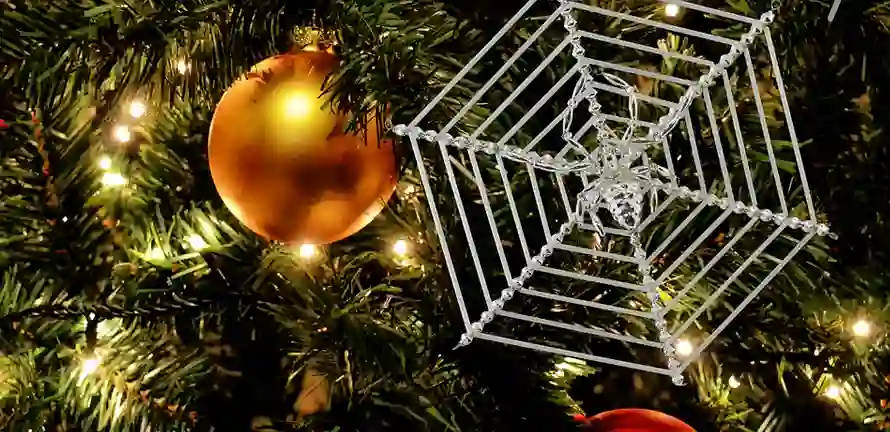
The legend revolves around a poor widow residing in a small dwelling with her children. Approaching Christmas, they lacked the means to adorn their tree with decorations. One night, a spider within the house observed their hardship and spun intricate webs all over the tree.
On Christmas morning, the family awoke to find the tree covered in these beautifully woven spider webs. As sunlight touched the webs, they transformed into strands of silver and gold, creating a dazzling sight. The family, delighted by this unexpected display, felt blessed rather than destitute. From that moment, the widow and her children were believed to have escaped poverty.
The tale symbolizes finding beauty and hope in unexpected circumstances, along with emphasizing kindness and sharing during the festive season. Some people incorporate spider-themed ornaments into their Christmas celebrations as a homage to this folk story.
2. Holi
Holi is an exuberant Hindu festival celebrated in India, signifying the onset of spring and the victory of good over evil. It is observed on the last full moon day of the lunar month, usually in February or March.
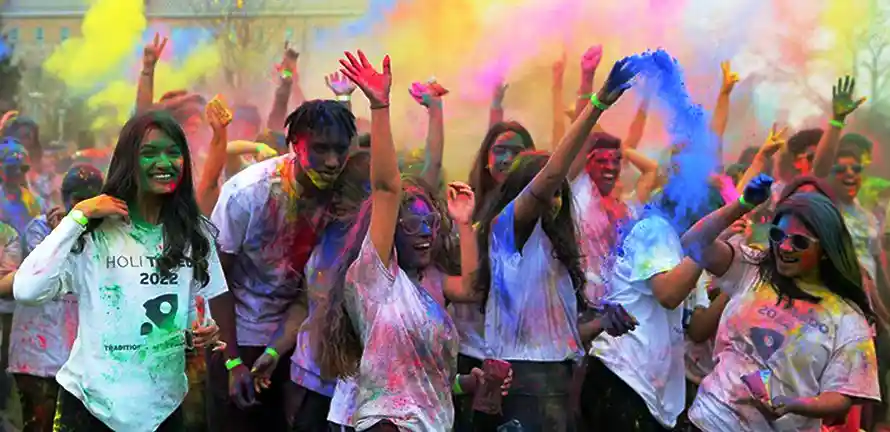
During this festival, people engage in vibrant celebrations by applying colorful powders on each other and playfully splashing water-based colors and balloons, creating an atmosphere of joy and liveliness. Holi is a time for families and friends to gather, mend relationships, and embrace new beginnings. Alongside the colorful revelry, the festival includes lighting bonfires, singing, dancing, enjoying traditional feasts, and sharing happiness and affection among everyone involved.
3. Kentucky Fried Chicken Christmas
“Kentucky Fried Chicken Christmas” refers to a popular custom in Japan where individuals celebrate Christmas by partaking in meals from KFC. This tradition emerged in the 1970s following a successful marketing campaign by KFC Japan.

Before this marketing initiative, Japan didn’t have a customary meal associated with Christmas. However, a clever advertising campaign by KFC, known as “Kentucky for Christmas,” effectively linked KFC’s fried chicken with the holiday season. This marketing portrayed the meal as a Western-style festive feast, resulting in its widespread popularity.
Consequently, pre-ordering KFC meals for Christmas has become a prevalent practice in Japan. Families often reserve their KFC Christmas meals well in advance due to the high demand. These meals typically consist of fried chicken buckets, assorted side dishes, and packaging designed with Christmas motifs.
This tradition has deeply rooted itself in Japanese culture, with many people incorporating KFC into their Christmas celebrations, even though it deviates from traditional Western customs of a Christmas feast. The attraction to this tradition lies in the convenience and the association of KFC with a festive, celebratory meal during Japan’s holiday season.
4. Krampus
Krampus is a legendary figure originating from Alpine folklore, particularly known in Austria, Bavaria, Croatia, Hungary, and some parts of Germany. This mythical creature is intertwined with pre-Christian winter traditions and often associated with Christmas celebrations.

Depicted as a horned, anthropomorphic being, Krampus typically appears hairy and demonic. According to tradition, Krampus is believed to accompany St. Nicholas (or Santa Claus) during the Christmas season. While St. Nicholas rewards well-behaved children with gifts, Krampus is said to punish misbehaving children.
Krampusnacht, or Krampus Night, is celebrated on December 5th or 6th. During this event, people dress up as Krampus in costumes adorned with masks and frightening attire. They take to the streets, sometimes participating in parades, with the aim of startling both children and adults. This tradition of Krampusnacht has witnessed a revival in various European regions and has gained popularity in other parts of the world, offering a unique twist to the holiday season.
Krampus is often considered a dark counterpart to St. Nicholas, symbolizing punishment for wrongdoing and highlighting the consequences of bad behavior. However, the modern portrayal of Krampus tends to be more light-hearted and less sinister, with the creature being part of festive events and entertainment during Christmas, rather than a fearful figure.
5. The Night of the Radishes
The Night of the Radishes, or “Noche de Rábanos” in Spanish, is an annual festival celebrated on December 23rd in Oaxaca, Mexico. This tradition originated in the 18th century when Spanish conquistadors introduced radishes to Mexico. To boost radish sales during the Christmas season, Oaxaca City’s market vendors began creating elaborate displays using these vegetables. Over time, this practice evolved into a formal event featuring artisans showcasing their carving prowess in a competition.

During the festival, participants intricately carve large radishes into various shapes, such as nativity scenes, religious figures, animals, and cultural symbols. These designs often reflect Mexican folklore, traditions, and local culture. The carved radishes are then exhibited in a designated area, and a panel of judges selects the most exceptional and creative sculptures.
The Night of the Radishes has grown into an integral part of Oaxaca’s Christmas festivities, attracting both locals and tourists who gather to witness the remarkable artistry and creativity displayed in these radish sculptures. This event honors craftsmanship, creativity, and the holiday spirit in Mexico’s cultural heritage.
6. Dussehra
“Dussehra, also known as Vijayadashami, is a significant Hindu festival observed on the tenth day of the Hindu calendar month of Ashvin, usually falling in September or October. This celebration symbolizes the victory of good over evil and commemorates Lord Rama’s triumph over the demon king Ravana, as depicted in the Hindu epic Ramayana.

The festival involves various customs and traditions, such as the enactment of Ramlila, which portrays scenes from the Ramayana on stages. On the tenth day of Dussehra, effigies of Ravana are typically burned, symbolizing the defeat of evil.
Dussehra often marks the culmination of the nine-day festival of Navaratri, during which different forms of the goddess Durga are worshipped. Celebrations include cultural events, fairs, processions, and special prayers at temples. It is a time of joyous festivities, spiritual reflection, and cultural importance.”
7. Mari Lwyd
Mari Lwyd is a traditional Welsh ritual rooted in the festive customs observed during Christmas and New Year in Wales, especially prevalent in South Wales. This ritual features a horse’s skull mounted on a pole and adorned with vibrant decorations and ribbons.

Participants in the Mari Lwyd custom typically parade the decorated horse skull, often concealed under a white cloth or blanket, while singing traditional Welsh songs called “pwnco” or engaging in rhyming verbal duels known as “the battle of wits.”
During the Mari Lwyd tradition, a group bearing the adorned horse skull visits houses and begins a dialogue by posing questions to the residents. The group asks for entry, and the household responds with rhyming verses of refusal. This exchange continues until the group is permitted to enter.
Upon gaining entry, the Mari Lwyd party and the occupants of the house often share refreshments, notably alcoholic beverages. The visit concludes with well-wishes for the household’s prosperity and welfare in the approaching year.
The Mari Lwyd tradition has deep cultural and historical significance, blending elements of pre-Christian beliefs with Christian celebrations. It serves as a way to bring good fortune and joy during the holiday season while preserving a link to Welsh folklore and age-old customs.
8. The Christmas Pickle
The Christmas Pickle is a tradition associated with hiding a pickle-shaped ornament within the Christmas tree’s branches.
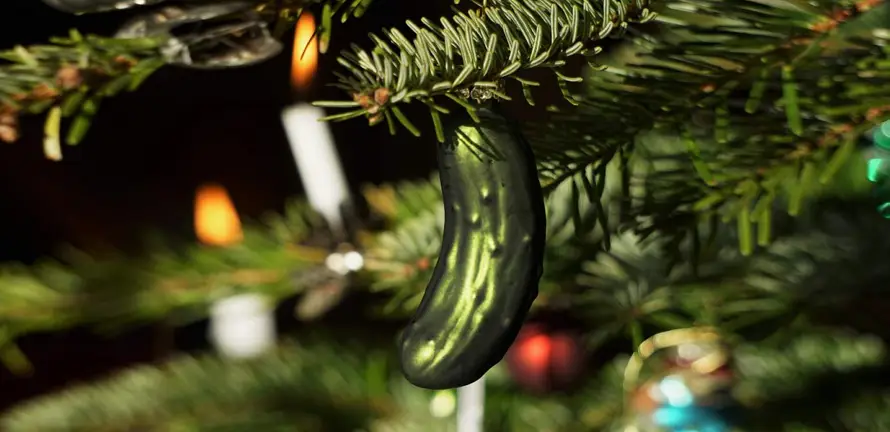
The first child who discovers the pickle on Christmas morning is either rewarded with a special gift or believed to have good luck for the forthcoming year. Though its exact origins are debated among historians and folklorists, this custom is thought to have German roots. Some speculate it originated as a marketing ploy in the late 19th century, while others suggest deeper connections to traditional German holiday practices. Irrespective of its precise origin, it has gained popularity as a playful tradition in many households, notably in the United States.
9. Burning Snowmen
“Burning Snowmen” is an annual event held in Bremen, Germany, marking the end of winter.
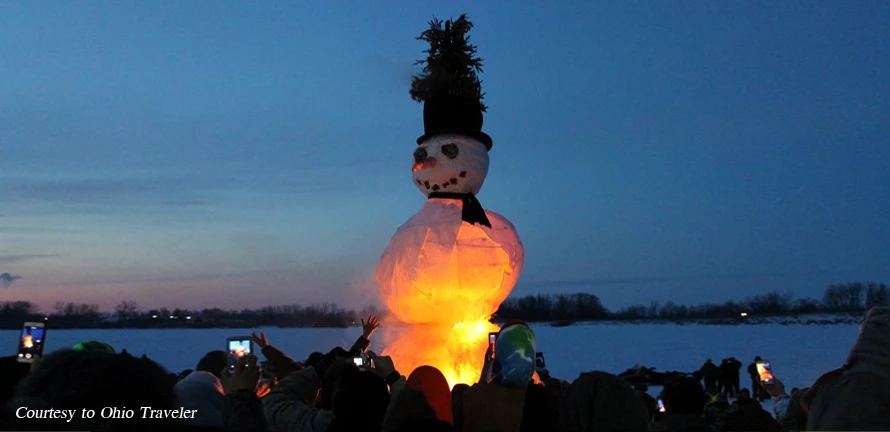
People construct large snowmen, and at the culmination of the event, these snowmen are set on fire, symbolizing the transition from winter to spring and bidding farewell to the cold season. It’s a festive occasion where people gather, enjoy food and drinks, and celebrate the arrival of warmer weather.
10. Dragon dances
Dragon dances are a customary feature of Chinese culture, often showcased during festivals and particularly prominent during the Chinese New Year. These performances typically involve a team of individuals manipulating a dragon made of silk, paper, and bamboo using poles.
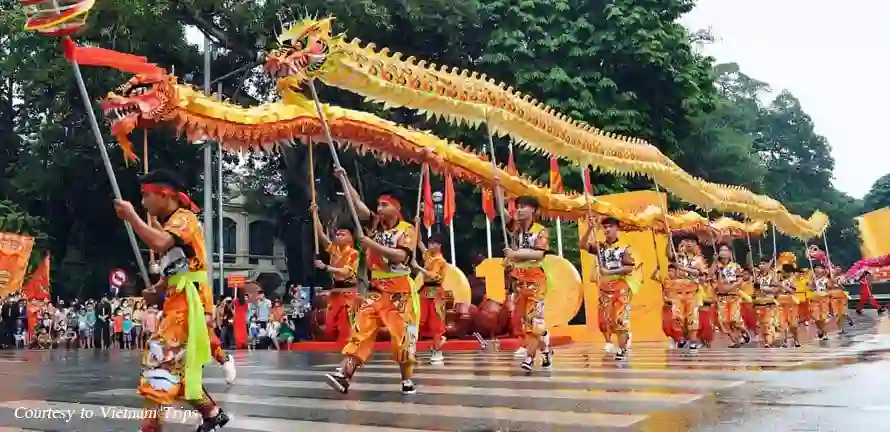
Coordinated movements bring the dragon to life, with performers utilizing their skills to maneuver it. The dance is accompanied by rhythmic drumming, cymbals, and gongs, believed to bring auspiciousness and ward off malevolent spirits.
Considered a symbol of wisdom, power, and good fortune in Chinese traditions, the dragon, often vibrant and lengthy, is a representation of these auspicious qualities. The dance is an integral part of festivities, aiming to bring blessings, prosperity, and joy for the upcoming year.
Hi…Just have a look at this also!



